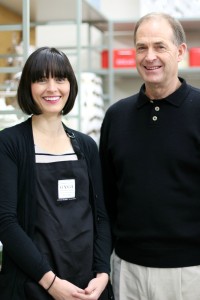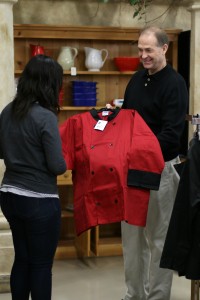Gygi: Up From the Ashes and Burning Bright in Salt Lake City
By Lorrie Baumann
Brad McDonald, General Manager for Gygi, is toying with the idea of someday opening a second location somewhere in metropolitan Phoenix. That seems only fitting since his Salt Lake City kitchen store has already risen from the ashes once, so a Phoenix is clearly something these folks know about.
Gygi was founded by Orson H. Gygi, McDonald’s grandfather, in 1945, when the American economy was just getting back on its feet after World War II. Gygi had been a sales manager for a restaurant supply company and had decided to start out on his own, going from door-to-door at restaurants and selling from his car trunk.
“He built everything we have today with a lot of hard work and dedication,” says McDonald. “My grandfather had very little inventory but he built his business by sacrificing a lot for the business and his family. He lived a frugal lifestyle and lived by the philosophy that if we can’t pay cash for it, we don’t need it.”
 Orson Gygi gradually built up his modest door-to-door business to open a wholesale restaurant supply store where, eventually, his four sons joined. Two of them were happy doing outside sales to the restaurants and the other two wanted to convert the business into a cash-and-carry store. So, they did both. By taking about 5,000 square feet of the 15,000 square foot warehouse they turned the store into a cash-and-carry retail store open to the public, while continuing to deliver wholesale equipment to restaurants.
Orson Gygi gradually built up his modest door-to-door business to open a wholesale restaurant supply store where, eventually, his four sons joined. Two of them were happy doing outside sales to the restaurants and the other two wanted to convert the business into a cash-and-carry store. So, they did both. By taking about 5,000 square feet of the 15,000 square foot warehouse they turned the store into a cash-and-carry retail store open to the public, while continuing to deliver wholesale equipment to restaurants.
Then came the fire, in March of 1998. “At that point it caused us to give some thought about the future of the business,” McDonald says. “We had entered a crossroads of whether to sell the business, or rebuild on the same property and turn the wholesale restaurant supply store to retail kitchenware sales. We decided on the latter, and I was elected to become Gygi’s new general manager.”
Today the store occupies about 40,000 square feet, with about 30,000 square feet of that a warehouse styled retail space where they sell everything to do with the preparation of food. Although the business still has some restaurant customers, its main focus is now supplies and education for home cooks.
The retail floor offers basically everything you can think of for culinary purposes ranging from disposable tableware to specialty food items not available in local grocery stores. Other items such as, specialty ingredients, emulsions and flavorings and specialty spices are all available for one to peruse throughout the store.
“At one time, we were the only place you could get anything in any quantity. We have some specialty ingredients, such as, flours and sugars, and we also supply a lot of chocolate, selling almost 750,000 pounds of chocolate a year out of the store alone,” McDonald says with a smile. “And that’s only accounting for the people who are using it as an ingredient.”
 Gygi’s buying strategy is to try to pick out only the best items from every line in the store rather than carrying the complete lines of all the brands that are represented.
Gygi’s buying strategy is to try to pick out only the best items from every line in the store rather than carrying the complete lines of all the brands that are represented.
“We select top brands and focus on what those top brands are best at doing, we then focus on that top item,” McDonald says. “Every manufacturer has its areas where they kind of hang their hat, and then they fill out the line with other products. At Gygi, we try to pick out those best products from every line.”
Among the 8,000 to 10,000 product lines carried in the store, Swiss Diamond, All-Clad, Le Creuset and WUSTHOF are a few of the most popular brands. Joseph Joseph cutting boards do very well, and so do John Boos cutting blocks.
“Fat Daddio’s is a pan line that is very popular among our customers. It’s a great pan line that bakes beautiful cakes. We’ve actually converted a lot of our own baking pans to the Fat Daddio’s line,” McDonald says.
However, it’s not only McDonald who works long hours to see his grandfather’s legacy live on; fourth-generation family member Heather Smith has been working in the store full time since 2000.
“I worked part time through high school, and soon realized it was a pretty cool place. I then moved out on my own and started cooking, that’s when working at Gygi turned from a career to a hobby,” Smith says. “I still don’t look at it as a job. It’s more of a passion, maybe even a lifestyle.” Today, she’s a mother of three: eight-year-old daughter Saige, six-year-old son Milo, and 20-month-old son Jep. “They’re my first priority, but Gygi is part of me. I enjoy it,” she says.
While job titles at the Orson Gygi Company are family-flexible, Smith is the company’s Culinary Director, managing a lively schedule of cooking classes.
 “Utah’s demographic is a changing atmosphere and it’s part of my job to see those changes in the classes. A lot of people are looking to cook healthier, rather than relying on traditional casseroles,” she says. “Taking a family out can be expensive, so with Utah’s larger families, people would rather entertain in their own homes, and they want to serve something different from the traditional church casserole. We’ve also started catering to our customers who aren’t sure what a church casserole is. We’re making Utah more of a foodie state than it ever was.”
“Utah’s demographic is a changing atmosphere and it’s part of my job to see those changes in the classes. A lot of people are looking to cook healthier, rather than relying on traditional casseroles,” she says. “Taking a family out can be expensive, so with Utah’s larger families, people would rather entertain in their own homes, and they want to serve something different from the traditional church casserole. We’ve also started catering to our customers who aren’t sure what a church casserole is. We’re making Utah more of a foodie state than it ever was.”
The typical hands-on class lasts around 2.5 hours with about 12 to 14 students, of whom around 20 percent are men who are just learning to cook. Most of the teachers are chefs recruited from Utah’s own local community, such as instructors from the culinary programs, chefs from local restaurants, and some are even local food bloggers. During the classes, students cook right along with the instructor chef. At the end the experience, they’ll sit down around a large table and have a family-style meal with the food they’ve just created.
“We have people who take these classes strictly for educational purposes and those who take them for social purposes as well. It’s an opportunity to sit down and have a nice meal with somebody,” McDonald says.
Gygi also has a theater-style demonstration kitchen that seats around 50, and the occasional class is still taught there, but the cooking school has really found its niche with the hands-on classes, he adds. The culinary center also functions as a laboratory in which new products are tested before they’re offered for sale. “It’s amazing how often we see a product that looks great, but then we don’t feel comfortable with the quality or the wear and tear of the product, in which case we won’t put it out on our shelves until we’ve tested it,” McDonald says. “We basically stand behind the products for life. We warrant customer satisfaction because the products that we do have are good-quality products. We learned a long time ago that the more risk you take away from the consumer, the more willing they are to buy, so we try to take that risk away for our customers.”
That philosophy extends to a recent major investment in the store’s e-commerce website. It’s currently generating about five to eight percent of total sales, but McDonald is hoping to grow it to become an equal or greater portion of the business. To that end, he hired half a dozen new people to ramp up the online operation, and a few months into the project, revenues are growing fast.
“We’re projecting that it could take three years to build the e-commerce business to equal the store’s sales, but the team feels that projected time allowance is overly generous, and they plan to reach that point much sooner,” he says. “We just hope that we can take people from large cities and hope that they’ll feel as comfortable as the people who come into our store. That’s our challenge – to personalize it.”
This story was originally published in the February 2015 issue of Kitchenware News, a publication of Oser Communications Group.


You must be logged in to post a comment.